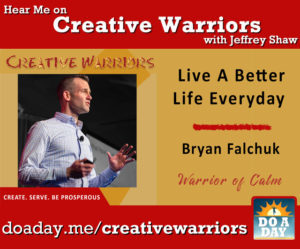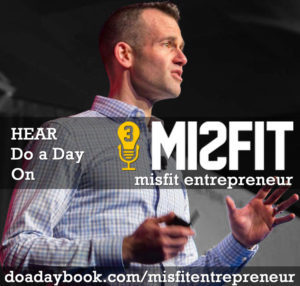Bryan David Falchuk's Blog: Do a Day Blog, page 2
February 1, 2018
Want to Achieve More in Your Job? These 4 Simple Things Can Help
If you said the biggest thing standing in the way of a company’s success is its competition, you’d be wrong. In fact, it is the daily ‘stuff’ that flies at you, demanding to get done as part of your day job that most stands in the way of success–for your company and for you personally. All the emails in your inbox, fires to put out, customer demands, administrative work, etc.
FranklinCovey, the makers of the eponymous day planners and experts on execution, call this daily challenge “The Whirlwind.”
Aside from wearing you out, the problem with The Whirlwind is that it keeps you from getting to the strategic things you need to do for long-term success.
To understand it, all you have to do is ask yourself how many times you got into work planning to get to that business plan or presentation you knew you needed to work on only to find half your day gone due to all the ‘right now’ demands that kept popping up.
One of the reasons for The Whirlwind from my experience is that we try to do too much. Between being short-staffed, having single-person dependencies and feeling like if we do not personally take on each task, someone will judge us for not pulling our weight. That is, we think our career will suffer if we do any less.
I would argue the opposite is true, and that is a key to FranklinCovey’s message.
Instead of doing too much to achieve more, paradoxically, the answer may be to do less to achieve more.
So how do you do it?
1. Schedule the Time & Protect it Religiously
This is something I do personally, and recommend to others almost daily. Set a block of time in your calendar for working on the big stuff. Then you have to protect that time religiously. This will likely feel uncomfortable at first, and you may worry about things falling apart or someone seeing your calendar and wondering what you could possibly be doing while The Whirlwind is busing swirling at full force.
Almost every day, I have at least an hour of my calendar blocked out for a specific goal I need to take action on. For example, I needed to work on my functions strategy for controls and compliance as our regulatory environment changes. I set time for that work specifically, and told some people trying to get time with me that I was not available. I got the work done, ensuring my function can proactively face these changes rather than scrambling last minute or creating problems with our regulators. That obviously would not bode well for my career.
If I do not proactively block my time, I end up scheduled all day long, but by holding at least an hour each day, I am able to ensure I tackle the bigger things I face.
2. Delegate If You Can
You may have people who work for you who can do some of your Whirlwind work. Think it is not possible for them to take something on in its entirety? Then break it into chunks and give them part of it.
For example, could someone do research to find the key info you need to complete a daily report? Could someone else work on scheduling all those meetings you have to setup? Could they do the work you have in draft form, and then give it to you to review and send out if you think they are not quite ready to produce their own outward-facing work?
I have done all of these things and instead of feeling like I am burdening them, I try to find things for them that would grow their skill set and understanding to help them along their development path. I was the main contact for a key vendor, which meant anything that came up with them fell on my plate. I introduced someone from my team to them, and using time I blocked on my calendar, I brought him up to speed on the relationship and the work so that he could then take it over completely. It has helped me, but he is also becoming very good at vendor management (and they’re performing better than when I was trying to manage them with the little time I could put into overseeing their performance).
3. If You Can’t Delegate, Create a Supporting Group
If you cannot delegate some of your work to make time for the bigger things, maybe you can fin another way to share the burden with a group of peers in the same boat. It is not quite a support group in the traditional sense, but rather a group of people supporting each others workload and strategic goals to make sure The Whirlwind is handled and the strategic things happen.
I have connected with a group of fellow authors who are all trying to achieve the same thing with our work. Rather than hiring a staff of people for each of us, we have split up some of the things we all need done, and are helping each other get there, such as researching podcast and radio shows to be on, or finding social media tools to help our books get out into the marketplace. It has reduced the burden on each one of us individually, while helping us all do better overall.
4. Create a Culture that Rewards Pausing from The Whirlwind
According to author and accountability expert Michael Levitt, celebrating wins might be the path to making this more acceptable across the company. He says,
“Organizations do not take enough time to celebrate our accomplishments. We get through our daily 2 to 3 item to-do checklists for the day, and instead of taking a moment to celebrate our accomplishments, we move on to the next item.
We end up hurting ourselves, or missing learning opportunities when we do not take the time to pause and learn from our accomplishments.”
What Levitt is suggesting is to create natural pauses from The Whirlwind to recognize accomplishment. And when it comes to accomplishing something strategic (either directly yourself or indirectly on the part of someone who took some of your Whirlwind so you could achieve the bigger thing), celebrating the win can make it even more acceptable for people to pause for the big things. The celebration helps to move the culture from being so reactive and frantic.
The Whirlwind will not stop on its own, so these four ideas can help you create room to really achieve more despite doing less.
This post is inspired by my best-selling book, “Do a Day: How to Live a Better Life Every Day” available in print, eBook and audio book formats. It originally appeared in my Inc.com column on January 17th, 2018.
January 24, 2018
This 1 Word Could Be Holding You Back at Work & Life
 How to Break the Cycle of Negative Self-Talk That’s Holding You Back in Your Career
How to Break the Cycle of Negative Self-Talk That’s Holding You Back in Your CareerI spent one third of my career as a management consultant. It was a great experience filled with a lot of learning and a lot of tough moments, too.
That means I was paid to find what is wrong, root it out, and figure out a better path forward. It made me a great problem-solver, but it had a downside–I (and others in similar jobs) was being conditioned to point out the negative in everything I saw.
The thing is, we all do this, especially with ourselves. Listen to how people talk about their workload or the hours they work. It almost becomes a competition for who is the most beaten down.
You often hear things around the office like, “I was at the office until 10 last night. I’m so beat!” Then a coworker will often respond with all this pride in their voice with something like, “10? Wow, you have it easy. I was here until midnight, and then did another three hours once I got home.”
Let me ask, which one of them is the winner in this debate?
Or when you try to commend someone on doing a good job, they often point out where they went wrong rather than just taking the praise. I remember giving a big presentation to a client early in my career, and a peer told me I did a great job afterward. My immediate response was, “No, I totally messed up that section about their growth strategy. Luckily they forgot about that once we showed them the savings involved.” I could not even start by saying, “Thanks,” before pointing out my failure.
And it is not just in work situations. Next time someone has you over for dinner, compliment them on the food, and watch what happens. You are likely to hear something like, “Thanks, but I overcooked it.” Or, “Maybe, but the potatoes needed more salt.”
This has become a major focus of my coaching work–helping people to get comfortable with being good at things. We are so entrenched in self-deprecation or denying our achievements that we end up framing ourselves with mediocrity at best or incompetence at worst.
How can you possibly be successful if you see yourself as mediocre or worse? The answer is obviously that you can’t.
However, you can change the situation. Here is the exercise I give people I work with. I call it “Stop the But.”
Stop the But
Say something good about yourself or something you did. As soon as you feel the word “but” forming in your mind, stop yourself. Just say the good part without anything to downplay it, take away from it, or negate it. Just allow the good.
Here are a few examples from people I work with.
The first is from working with a woman who was so caught in her not being smart enough for the job she wanted, she thought they made a mistake or there was something wrong with the company when they offered her the job.
So I asked her about how she did in college. She said, “I got good grades, but…”
I jumped in there and cut her off by saying, “Stop. You got good grades. Leave it there.”
But she could not do it, and responded with, “No, that does not matter. It was so long ago. And what I studied is not relevant to what I want to do. So who cares?”
The point is just to allow the good thing about you to sit unchallenged. Of course that good thing may not be relevant in every situation, so why bother naming specific reasons for it to be invalid in any one context? Good grades are also not relevant to whether she is good at basketball, can fly a plane, or any number of other unrelated things. So choosing one to focus on to discredit the good is no more rational than just letting the good be as it.
Another person was having trouble getting along with his boss, and was broadening that out to a general issue with people, and then catastrophizing that he was unemployable, and his career was doomed.
So I asked him, “Do you have friends?”
He said, “Of course I do. But–”
I cut him off right there. “You have friends. People who were not born into knowing you actively choose to be connected to you. Are they close friends or more like acquaintances?”
“Good friends. In my circle of friends, I am kind of the go-to person when people are really struggling with problems in their job. They all turn to me.”
I said, “Ah ha! So people are specifically turning to you for advice about career issues. People who have made a decision based on the kind of person you are to do this.”
Through this exercise (which we repeated a few times) he stopped seeing himself as doomed because of his inability to be a relatable person, but rather realized there are people he does get along with well and others that may take more work.
This is something I have people do daily to start to counter-act the years of negative self-talk they have been engaging in throughout their lives, let alone their careers.
What About Humility?
One person I was mentoring pushed back. He said he was being humble when he inserted the “but”. He did not want to seem egotistical, so a little self-deprecation was just about good social skills.
I told him I think that is a cop out. Let me explain with an (extreme) analogy.
If I fired someone for harassing another employee after a specific and severe incident, that would be a justifiable reason. If I fired everyone who ever disagreed with a coworker for harassment, that would be over-using the reason. That is, sometimes it is appropriate, and sometimes you are using it as a cop out.
If you want to be successful, you have to allow for the possibility that you are actually good at things and capable of success. You cannot discredit every little attempt to credit you with a win and expect to have hope that you can achieve what you aspire to in your career.
This post is inspired by my best-selling book, “Do a Day: How to Live a Better Life Every Day” available in print, eBook and audio book formats . It originally appeared in my Inc.com column on January 10th, 2018.
January 17, 2018
What Doing 87 Podcast Interviews Taught Me About Building a Social Media Brand
 Building your social media brand is not about tricks and tools. It’s about these 4 things.
Building your social media brand is not about tricks and tools. It’s about these 4 things.I published my first book last March, which was an amazing achievement and the culmination of almost a year and a half of serious effort. The effort to successfully promote it can be even greater than to write and publish it in the first place.
How did I do it? I did interviews. A lot. Since April, I have been on 87 (and counting) podcasts and radio shows so far.
In the process, I learned a lot about not just promotion, but what it takes to make something of all those interviews and creating a meaningful social media following. I am still nowhere near many major influencers out there, but I have grown my following 10-times in the eight months I’ve been doing shows, and I have realized the four key things that lead to this.
This is not about sharing tricks or tools to life hack your way to more followers, and it is not about where to buy lists of followers or how to spend advertising dollars to get there. It is about who you are out there in Socialmedialand to resonate and create a following that fuels your success.
Whether you are doing something on your own, like me, or building it for your business, these lessons apply.
 1. Consistency Matters
1. Consistency MattersThis is advice everyone gives over and over again. I knew it was true, but secretly wished it was not. I kept waiting for something I put out there to go viral to save me from having to put in the consistent effort.
The truth is, the world does not generally work that way, and it does not work that way frequently enough for it to be your strategy. So you have to put in the work. Every day.
The proof was there for me this past November. Due to the Thanksgiving holiday, fewer shows featuring me were released, and my book sales were the lowest they had been any month since publishing. And in December, appearances picked back up, and so did sales. It was a direct, 1:1 relationship.
I also saw this with Twitter posting. The days I had more time to share content, my followership and engagement were noticeably higher. I would consistently grow my followers by at least 100 people on those days. Days when I was offline due to travel or being busy with meetings and interviews, I might grow by 20 to 40 people. Again, it is correlated clearly enough to prove that consistency matters.
 2. Know the Short & Long of Your Story
2. Know the Short & Long of Your StoryDoing so many interviews, I have told my story over and over. I never get tired of telling it, nor has it been hard to do it over and over.
What was hard for me, was to figure out how to concisely tell this big story that spanned decades. It starting with childhood obesity as a result of depression and anxiety sparked by my parents’ divorce culminating in a moment 30 years later when it looked like my wife was about to succumb to chronic illness while our son, who was two at the time, watched.
Some shows I have been on were over an hour, so there was plenty of room to tell the story. Some shows have been as short as 15 minutes, with much more to talk about than just my backstory as I still had to get into what that lead me to do. I had to learn how to condense and expand my story in a way that could fit various lengths of time, but also still resonate and grip the audience. They needed to come away engaged and able to fully understand the power of the story as a catalyst to change your life.
To do it, I sat down and thought about what the most salient points are. I always asked the host what their target time was, and then mentally went back to my plan so I could get my message out in the time I was being given.
Then it boiled down to Practice Makes Perfect.
 3. Not All Publicity is Good Publicity
3. Not All Publicity is Good PublicityThe old adage is simply not true–at least not when your brand is involved. Brand-building is about the long haul, not about short-term pops in activity. I have been asked to be on popular shows that have a tone or message that is out of sync with what I talk about, like those that focus on politics (and take strong sides in the hotly-debated world of American politics right now), conspiracy theories or other negatively-themed shows.
Before saying, “Yes,” I always listen to a few episodes to see the kinds of guests they have on, the tone the interviews take, and whether it feels out of sync with my values. Sometimes I have had to pass on shows with major listenership that would have helped my book sales in the short-term. But in the long-term, I had to recognize what that could mean for my brand–how people see me and what I stand for if I was to be part of something negative and attacking.
Despite the attention it may bring, sometimes you have to pass on opportunities for the big picture.
4. Be Genuine & Vulnerable
Lastly, the thing I always tell people is to stay true to who you are. I open up about myself in hopes of others identifying with my story through shared experience, and then they can find inspiration through our connection. Marcus Lemonis talks about the importance of vulnerability in business, and it is just as true in building your brand. Be open, be honest, and be you. That is what your brand is after all.
 And you have to be genuine in the process. Being vulnerable does not mean making up or embellishing experiences so people latch onto your message better. You have to be you, as you are. If you are open about your genuine experience, the right people will connect to you, and you will build your following with people who truly want to follow you, not some contrived appearance you have to work to keep up.
And you have to be genuine in the process. Being vulnerable does not mean making up or embellishing experiences so people latch onto your message better. You have to be you, as you are. If you are open about your genuine experience, the right people will connect to you, and you will build your following with people who truly want to follow you, not some contrived appearance you have to work to keep up.
The good news is, as I start work on my second book, I now know first-hand the value of these lessons, so I can apply them proactively for my second book launch. Aside from that, I also now have an engaged following of a brand I have consistently and genuinely built.
This post is inspired by my best-selling book, “Do a Day: How to Live a Better Life Every Day” available in print, eBook and audio book formats . It originally appeared in my Inc.com column on January 3rd, 2018 .
January 3, 2018
5 Questions You Should Ask Yourself Before Quitting Your Job
We have all had bad days at work–whether you screwed something up, got yelled at, had to fire someone or lost a big account. But have you ever had a bad year?
In a recent interview with a C-level executive who is nearing his retirement, he said, “I have been here for 31 years, and only one of those was bad.”
You could say, “One out of 31–that is pretty good! His career scores a 97% for good years.”
While it is pretty good, the idea of an entire year being bad is tough to swallow–especially if you are in the middle of that year right now. And while the impact on you may be obvious, what about all those around you – especially if you are in a leadership role?
The question is whether you should stick it out or jump ship. As the 80s hit by The Clash asked, “Should I stay or should I go?”
While that may be the simple question you are trying to answer, you actually need to ask these five questions to unearth your answer.
1. Is this bad situation a short-term problem or a permanent shifted?
Sometimes, we hit rough patches, and it’s no different for companies or jobs. Is this just a phase that you or your business needs to go through?
For example, in my career in insurance, we have had regulators come in to examine us for months on end–it was difficult, invasive and disruptive. But it ended, and life went on (assuming their findings were benign).
You could also find yourself in a situation where your business has totally shifted, and is no longer sustainable. For example, chip-maker Imagination Tech saw their business implode overnight when Apple, who made up the vast majority of their sales, moved to an in-house solution for graphics chips.
2. Is there a specific end-point to the badness?
If you find that that causes of the bad times are not permanent, can you identify an end date? Do you have a miserable coworker or boss who is retiring in a year? Is your system totally inadequate, but being replaced by a new system in the next year? Are you in a financial jam but just need to make it through to raise or bonus time to get back to stability? Are you in a position of power, and have the ability to change things?
While it may still be hard in the interim, knowing that there is an end in sight can make it much more bearable. You go from having a serious problem to having what I call a “Fast Forward Problem.” That is, you just need to hit the fast forward button and get through it, but you will get through it.
3. Has your bar reset to some unrealistic level?
Sometimes, after being in a great company for a while, your sense of reality resets, and you come to expect that greatness rather than appreciating it.
I have been lucky enough to work for an unbelievable company that really stands apart from all others in its space. When people are new, they spend the first couple of years constantly smiling and being blown away by how good it is. After that, they start to take it for granted and seem disenchanted. This is especially the case with recent college grads who have never worked elsewhere, so they lack a comparison point.
Some leave for what they believe to be greener pastures. Many end up leaving that job within a year, and a surprising number end up reaching out about coming back within their first year of leaving–something I have never seen before.
So perhaps the problem is more about perception and how you are choosing to look at the situation.
4. Have your core values shifted, creating a misalignment with your job?
When our jobs do not align with our values, they quickly become unbearable. There is a popular TED talk by Robyn O’Brien who was a very successful lobbyist for the food industry. She is currently a crusader for improving dietary habits in America that is completely at odds with her old job. She had a wake-up moment as she looked at the health data that changed how she felt about how we eat in this country and what it is doing to us. After that point, she could not stay at her job any longer because it was so at odds with what she believed in.
5. Are there alternatives?
Finally, it is important to ask yourself if you have alternative options.
There may be other roles in the company you could apply for. To help your chances, you could reach out to people in those roles or departments to learn more, shadow them, build a relationship so they think of you when they have an opening, etc. Perhaps there are options in other offices you can pursue. I had an employee move to another office after being in the same one for nearly a decade, and she was totally invigorated and blossomed into an almost totally new person.
If you do not have another job option somewhere else, you could start to look for onewhile still keeping your current job. While you may want to leave right away, aside from the financial benefit of staying employed, you are also a much more attractive candidate if you are currently employed than not. Sometimes that is out of your control, but if it is in your control, it may be worth sticking around until you find your next option. Your resume will be stronger for it, and that creates option value down the line and saves you from having to explain a gap in your resume.
If you have one, you could also use a side-hustle to give you a second income stream you can lean on and keep your resume intact. Or perhaps your side-hustle can become your main job and this is the catalyst you needed to spark taking the plunge.
Lastly, it is worth mentioning again that you may have the power to change things. Whether you are a leader or not (but especially if you are), you may not be the source of the problem, but that does not mean you cannot be the source of the solution.
The next line of the song by The Clash is, “If I go, there will be trouble. And if I stay it will be double.” Maybe, maybe not, but now you have the questions to ask yourself to figure out which is the smart path and what to do about it.
This post is inspired by my best-selling book, “Do a Day: How to Live a Better Life Every Day” available in print, eBook and audio book formats . It originally appeared in my Inc.com column on December 20th, 2017 .
December 27, 2017
Have a Leadership Role at a Startup? Learn This Exec’s 9 Keys to Success
 Working at startup can mean wearing many hats–especially in a leadership role. Here are 9 tips from an expert to help you succeed.
Working at startup can mean wearing many hats–especially in a leadership role. Here are 9 tips from an expert to help you succeed.With all the activity in the electric car space, there are a number of innovative solutions coming together to charge all those cars. One of them is Volta Charging, who recently won the 2017 Cynopsis Social Good Award for Best Environmental Initiative. Volta is building a network–the largest in the U.S.–of ad-supported, free charging stations. Free charging is a major driver of electric car adoption, so Volta is helping to reduce our carbon footprint even faster.
One person at Volta helping them grow is VP of Operations, Jon Michaels. Jon has held various roles in the energy sector, but started his career as a helicopter pilot in the Navy. The varied challenges and extreme pressures he has faced prepared him well for the broad set of responsibilities needed to make a fast-paced startup successful. Looking back on his first year at Volta, Jon has come up with nine key aspects of what can make a leader in a startup success.
1. Smooth is fast
Do not move fast just for the sake of moving fast. A well-orchestrated series of actions executed smoothly and professionally is what moves organizations forward quickly. This means you will need to balance making some decisions quickly with imperfect (or no) data, with letting some topics ‘soak’.
2. Wait…what is soaking?
Good leaders are curious. They absorb information about potentially important trends and developments all the time without constantly reacting. They contemplate. They read more.
They have what former GE CEO Jeff Immelt calls a “soak period” before concluding what the information means for their company.
Give the idea some time to soak in. Resist the urge to be reactive or jump, but rather think through the idea, play it out in your head, and then reflect.
Sometimes a long soak period is not just acceptable, it is needed.
 3. Fail well
3. Fail wellBe able to experience painful failures that provide big learnings without failing badly enough to get knocked out of the game. It is not just, “move fast and break things,” but rather “if things break, work for them to break in pieces you can reuse and build on.”
3M’s Post-It business started this way. They were working on a new adhesive–only problem was it did not really adhere. They could not figure out what to do with this thing that sort of sticks.
Instead of focusing on what the adhesive could not do and shutting the project down, they looked at aspects of what it could do and found a gap in the market for notes you could stick, remove and re-stick all without damaging what you stuck it to. Out of that failure, Post-It notes were born.
4. Keep the Finance team close
It can be easy to have a mindset focused on your part of the business and overlook important collaboration points regarding budgets. Coordinate early and often with Finance on your initiatives and you will be in a position to succeed. This helps ensure your needs are considered when setting budgets or working on fundraising–two life-or-death things for startups.
If your initiative requires spending on software development or buying equipment, you may lack the resources at your disposal to pay for these things–especially at a cash-strapped startup. The financial wizards you work with can help solve that problem through their knowledge of what resources are where, or what alternative financing options may exist.
Without them understanding what you are aiming for, they will be much able or inclined to help.
5. Learn how to interview and hire for an unfamiliar discipline
You will be interviewing and hiring many people in areas you do not know a lot about. Start by trying to do (at least some of) the job yourself. This way, you will know exactly what the role entails and what questions to ask job candidates.
Enlist experts from your network and your advisors to better understand a role. Whatever approach you take, you’ll need to come up with an approach to help the organization grow.
6. Look for force multipliers

You cannot just throw money at problems and hire more people. You need to enable one person to have the impact of 10. Force multipliers do that. It could be outsourcing certain activities (and having one person manage the work of 10 contractors) or enabling your team with software or other tools.
For example, if you cannot afford lots of powerful servers to crunch through a huge dataset, why not consider a cloud computing solution? Having your employees try to use their computers to do it will be too slow and make their computers nearly unusable, hurting the team’s productivity. Offloading that task to the cloud is cheaper per month than buying servers would be, gives you access to huge amounts of power, and lets your team get back to work.
Have people working remotely to save on travel and office costs, but are you finding things are moving too slowly because of a dispersed workforce? Try one of the many collaboration tools out there–both free and paid–to speed up the pace of change by bringing people back together virtually. Tools like Skype, Facetime, Google Docs, Slack, Zoom and Huddle can make a big difference.
No matter what, you need to find your force multipliers.
7. Develop a mantra
A mantra is easy to remember and helps emphasize crucial points. As a (former) military pilot, Jon and his peers were ingrained with a mantra: Aviate, Navigate, Communicate (in that order). In his team at Volta, they have a mantra of execute effectively, execute collaboratively, and execute with a smart sense of urgency. Those three items guide all their actions.
8. You are setting the rules
There is no blueprint for success. You will change the way you work as often as you need to. If something is too slow, you change it. If a process causes errors, you change it. You have no guide to follow, so you must learn to be a problem solver to succeed.
If you feel trapped by people saying, “Yeah, it is annoying, but that is the way we do it,” then a startup may appeal to your throw-out-the-rule-book mentality.
Unlike big companies, startups have not yet defined all the rules or layered on process and protocol, so you can work in a less-constrained way while getting to define how things get done in the process.
I’ve worked with several startups and small businesses, and one of the most common complaints I hear from employees as they start to scale is “we’re becoming too much of a big company with all these rules.”
Being at startup gives you freedom from excessive or unchangeable rules, while also giving you the responsibility to help keep them from creeping in and crushing your culture.
9. Ask your employees even more questions
The best leaders do not provide all of the solutions–this inspires curiosity, creativity and deeper thinking in employees. And that starts with asking the right questions.
Encourage your employees to slow down and explain what they are proposing in more detail by saying something simple and to-the-point, like, “Wait, what?” You could also use phrases like, “I wonder why…” to encourage curiosity. And then follow up with, “I wonder if things could be done differently.”
Jon leaves us with one last bit of advice,
“Enjoy the ride. It will be bumpy, but hugely gratifying.”
This post is inspired by my best-selling book, “Do a Day: How to Live a Better Life Every Day” available in print, eBook and audio book formats . It originally appeared in my Inc.com column on December 13th, 2017 .
December 21, 2017
Shorts, Tights or Who Cares?
Oncs, I was at an offsite meeting for work at an amazing resort in the Poconos. I’s never been to the area before, but it’s similar to much of the Northeast—beautiful, not-over-populated, wooded areas. That includes having some great spots to run in, including a gorgeous PGA golf course across the street from the hotel, and a paved running path around the hotel (plus some mulch paths and unpaved trails, too). Since it was a little chilly compared to the 80+ degree weather I had been running in, I packed some running tights. I have a lot of them, and I feel bad not getting a chance to make use of them given the money I’ve spent on them. It’s definitely a risk when being around coworkers, but I tend to get up and start running before others.
I should correct that last sentence to read, “…almost before others.” On both days, I saw a coworker, including our CEO, at the end of my run.
 I decided I didn’t care. It’s more important to me that I’m running than what I’m seen running in. I don’t run for anyone else. I don’t care what I look like when I run, and I have nothing to be ashamed of.
I decided I didn’t care. It’s more important to me that I’m running than what I’m seen running in. I don’t run for anyone else. I don’t care what I look like when I run, and I have nothing to be ashamed of.
But it got me thinking about running attire and what is considered socially acceptable for men. Women can run in boy shorts and a sports bra without being considered inappropriately dressed (they may not be comfortable in that little, but people aren’t likely to glare at them for wearing inappropriate clothes). For me, the question comes down to two articles of clothing – tights (whether pants or spandex shorts) and short shorts. By ‘short shorts’ I mean the
So here are the questions – does it matter? Should you care? Should others care? And if so, which is worse, tights or short shorts?
What better way to figure this age old debate out than by running a poll! Take a sec, and cast your vote. You don’t have to be a man to have an opinion.
Note: There is a poll embedded within this post, please visit the site to participate in this post's poll.
Be sure to share this with friends (especially those you know who wear one of the two questionable garments!), and let’s get some insights on our culture, and perhaps a few laughs.
 When I got back from my first run after getting home from the trip. I wore a pair of 7″, loose Nike running shorts. Basically as opposite to what I wore in Pennsylvania as I could get, so I guess on average I’m doing ok, right? Now let’s just see how things are at work now!
When I got back from my first run after getting home from the trip. I wore a pair of 7″, loose Nike running shorts. Basically as opposite to what I wore in Pennsylvania as I could get, so I guess on average I’m doing ok, right? Now let’s just see how things are at work now!
In all seriousness, we want to feel comfortable in life. That comfort needs to come from within, not from what others deem comfortable. Don’t worry about what you look like unless you don’t like how it makes you feel. Worry more about doing right by yourself and achieving for yourself. Achievement with comfort that comes from within is a key to enlighten.your.body.
December 20, 2017
The Biggest Action Uber’s New CEO Should Take to Turn Things Around
 (Steve Ringman/The Seattle Times via AP)
(Steve Ringman/The Seattle Times via AP)With all the drama Uber has had, should it change its name to move forward?
Uber has done a lot to transform transportation for millions of riders, and create flexible job options for drivers. It has been such a success story and driver of change in a stagnant industry that “the Uber of [fill in the industry name]” has become a common phrase to describe startups that are trying to disrupt their space with lofty expectations of success–like the Uber of Dog Walking (yes, that is a thing).
It has also been at the center of a lot of controversy. From gender biases and sexual harassment, to a law suit by Google, to law suits from drivers, to unflattering videos of Uber’s founder and former-CEO, Travis Kalanick, mistreating drivers, to a very dramatic board fight and ousting of Kalanick, to a very public CEO search, to meddling by Kalanick to the most recent drama around the covered-up data breach of 57 million accounts–a long list that probably does not even cover it all–they have had a lot of drama.
A lot. And while Uber has still grown during all of this, several competitors like Lyft have seized on the opportunity, for example making a very public statement around immigration policy at a time when Uber was being roasted in the press for its silence on the matter.
New CEO, Dara Khosrowshahi, has had a lot to deal with, and has made a lot of progress on several fronts despite alleged continued attempts by Kalanick’s to control the company. With the most recent drama, he has been pulled in since he was aware of the breach for several weeks before it was reported.
Despite everything Khosrowshahi is doing to right the ship and repair the brand damage, could it be too much to fix? Perhaps the time has come for the Uber of ride sharing to be called something else.
Many companies have changed their name for positive reasons, like Apple dropping “Computer” from its name when it was clearly not primarily a computer company. Tesla dropped “Motors” when it acquired fellow-Musk-startup Solar City.
Some companies have done it to distance themselves from a more negative past. Philip Morris became Altria in 2003 to try to separate the overall company from its cigarette-making division so there would be no “second-hand smoke” on other brands it owned, like Kraft. The branding consultant they hired said that the name change, “…offers the possibility of masking the negatives associated with the tobacco business.”
Accenture used to be Andersen Consulting until its former parent-company, accounting firm Arthur Andersen, went down in flames in the wake of the Enron scandal with a lot of public backlash.
This is the situation Uber may be facing–too much negative attention to be able to truly move forward.
On the other side of the coin, several companies that went through major scandals retained their names (some only to face another scandal later), like Audi with the sudden acceleration scandal in the 1980s, Toyota with its sudden acceleration mess in 2009 and 2010, VW and Audi with their “dieselgate” scandal, or Chipotle with their E. coli debacle in 2015. Even Dow Chemical’s and Monsanto’s names survived Agent Orange.
Russ Findlay, Chief Marketing Officer of small business insurer Hiscox USA, thinks Uber should stick with their name. He said,
“Brand awareness is hard to build–once you have it, it’s far easier to maintain it than grow it. Rebranding is choice of last resort–you’re saying to the market is the perception of your brand is so despised that consumers will not do business with you.
Uber’s brand is dented not broken.”
So what do you think? Should Uber rebrand itself? Or should it keep working to fix their image and hang onto the brand equity they have built–even if it is negative equity right now?
If I was in Khosrowshahi’s shoes, I would be thinking hard about a new name.
This post is inspired by my best-selling book, “Do a Day: How to Live a Better Life Every Day” available in print, eBook and audio book formats . It originally appeared in my Inc.com column on December 6th, 2017 .
December 14, 2017
The 1 Thing You Need Most in a Mentor (That Most People Try to Avoid)
 Mentors can help you build your career as a leader, but to really help you grow, they may need to be tougher than you want.
Mentors can help you build your career as a leader, but to really help you grow, they may need to be tougher than you want.Having a mentor can have a tremendous impact on your career. The right one can help guide you through complex situations, work on self-growth and development needs, advocate for you and more. Most people with positive views of their mentor tend to have relationships with them that are very supportive and encouraging. Those are great things to have in a mentorship relationship. However, you can cross the line to where it becomes counter-productive.
How could a positive relationship with someone who cheers you on and stands by not be helpful? That sounds backward.
The reason is that a key difference between a good mentor and a great one is one who will challenge you. If you share an idea with your mentor, or talk them through a tricky situation, it will no doubt feel better if they just support your views and actions. Agreeing with you that you did the right thing or avoiding telling you about ways you might have come up shore will not be serving you in the long run.
Let’s take an example I have seen first hand, because I was the mentee in this example. I had presented my big idea about changing our sales structure at an important meeting that my mentor was at. Basically, my idea was not adopted because, frankly, my argument as I made it had a lot of holes.
On top of feeling defeated and frustrated by my idea not getting approved, if my mentor gave tough feedback about holes in my argument or ways my presentation was lacking would only hurt more. I may have been open to the feedback, but it would not feel good. What felt good was what my mentor did–she told me how perfectly I had done, and that the others in the room just were not ready for the change.
A year went by, and sales were not shaping up the way they could have. I had gotten closer to our COO, who was a tough, direct person. He had also been in that meeting. We were talking about the sales issues, and told me plainly how I missed an opportunity to change the game by blowing that presentation. I was so surprised (and slightly offended)–I had no idea I had been the main reason why the idea died.
He was really honest about how I could have done better, and also what the ramifications of my presentation were for me because of how much time had passed without me demonstrating an ability to strengthen my weaknesses. He gave me the feedback I needed so I knew how to try to turn the situation around.
With his guidance, I was able to get my idea adopted, and sales did turn around.
Comparing the two mentor styles around the same issue made things clear. One certainly felt better than the other in the moment. The other felt better for my career.
There’s nothing wrong with having a nice person as your mentor. But you have to make sure you get critical feedback and challenge from them so you can really grow. If you are not getting that, you have a friend, not a mentor.
The good news is, you can have both, so if you are not getting challenge from someone senior at your organization, go seek it out so you can really grow.
This post is inspired by my best-selling book, “Do a Day: How to Live a Better Life Every Day” available in print, eBook and audio book formats . It originally appeared in my Inc.com column on November 29th, 2017 .
December 5, 2017
3 Simple Secrets to Help You Get Fit While Traveling for Business
 Think being a road warrior means you cannot be in shape? Follow these three principles to stay healthy no matter how much you travel.
Think being a road warrior means you cannot be in shape? Follow these three principles to stay healthy no matter how much you travel.I’ve traveled a lot over my career. It’s often an every-week situation with two to four flights, hours of driving, multiple hotels, early mornings and late nights, and plenty of meals on the go. When I say I’m an experienced road warrior, I mean it.
I was also obese as a kid. When you combine that with my business travel, people always ask me how I’ve kept from becoming overweight again.
More relevantly, I’ve kept the grind of travel from leading to a downward health spiral that decreases my ability to perform in a high-stress job. Being healthy is directly related to better performance on the job–and can even make you a better entrepreneur.
It hasn’t always been easy, but it’s been far easier than I thought it would be. It boils down to making better choices across three things–set yourself up to be active, make good food choices and use time with purpose.
Set Yourself Up to be Active
I make a conscious choice to stay active every day while traveling for business. That takes planning, but once you get into a routine with it, it becomes easy. Here’s my routine:
Make sure you have workout clothes in your bag at all times. Pack unstructured, minimalist sneakers that can squish down–like Nike Frees, for example–so they don’t take much space. Tie your sneakers to your backpack or briefcase if space in your bag is a problem.
Scope out hotels online to be sure their gym works for you. If you like the elliptical machine, make sure your hotel has at least one of them. If you like to run outside, call and ask the concierge for local running routes.
Sometimes, you just cannot get to the gym for some reason. Be prepared with backup options you can do right in your room. YouTube is full of free workout videos, yoga programs, and more. Find a few you like ahead of time so you can use them in a pinch. I travel with a resistance band to make sure I can get some resistance training anywhere.
Make Good Food Choices
Life on the road can be indulgent. Eating out for all of your meals means you will be faced with fast, fatty, sugary (and delicious) options at every turn. Here are my tips:
Limit the chances of facing bad choices a few ways. Travel with protein powder packets and a Blender Bottle to fuel and fill-up at breakfast to avoid hotel breakfasts, which are typically full of pastries and sausage. Or travel with oranges and a few low-sugar, high protein bars to make sure you have good choices to grab in a pinch.
When eating out, focus on the appetizer section. Choosing a dairy-free soup and salad can preemptively make you too full for a heavy main course (it also keeps the bill smaller–hello, expense management). And you can steer restaurant choices to places that inherently have healthier options.
Use Time with Purpose
Lastly, be purposeful with your time. Here are two big time-management strategies I learned to use:
Set aside the smartphone. This is a tough one for many, but not pulling your smartphone out every free moment you have will keep you from the black hole of social media updates, and emails. Keep the phone out of your hands to keep yourself active.
Hotel gyms are usually jam packed from 6-7 A.M. and 5:30-7 P.M. Try to get there before 6 A.M. so you can get right on the machine you want to use. If that’s too early for you, go after 7 P.M. Waiting for equipment likely means not working out that day.
Some of these suggestions may sound too hard to do. The good news is, any one of them can help, so start small and make a change you can handle.
Staying fit and healthy despite the strain of travel will help you stay on top of your business-game. One success will lead to another, and soon you will find yourself making a series of smarter choices as you start to feel and look better despite your road warrior status.
This post is inspired by my best-selling book, “Do a Day: How to Live a Better Life Every Day” available in print, eBook and audio book formats . It originally appeared in my Inc.com column on November 21st, 2017 .
November 29, 2017
Advocating for Yourself Can Make or Break Your Startup (And Save Your Life). Here’s How
I, like many other people, have had surgery. Unlike many people I have had surgery 15 times. People always ask me what they were for, and I jokingly say “everything.”
I have also been involved in several startups that went through fundraising from venture capitalists.
Surprisingly, there is a huge overlap in what I learned from persevering through all those surgeries and fundraising with venture capitalists: be a self-advocate.
Through my surgeries, I have learned how different anesthesia and pain medications affect me, and know which ones cause complications, which ones do not work for me and what my tolerance for pain is. Opiates like Percoset and Morphine do not cut my pain, but do make me really nauseous, and anti-nausea medicine (called antiemetics) actually makes me nauseous. I know, it sounds backward, but I have had more than enough experience to know.
Going into number 14, the anesthesiologist came to meet with me, and saw the comment on my chart. He laughed, and said, “That’s not true.” I assured him it was despite it being strange, and he said, “Well, I use good stuff, and I know what I’m doing. You have to have the pain meds, and I can take care of the nausea easily with other drugs. You’ll be fine.”
This is where self-advocating became crucial because what he was insisting was going to make my recovery a lot worse. He was also clearly offended by the notion that I might have an opinion about his expertise, and felt like I was challenging his knowledge.
That made for a very tricky situation because my life is about to be in this doctor’s hands, so how I deal with it really matters. Before I share how I did it, let me share how it relates to my venture capitalists experience.
This reminded me immediately of times I’ve been working with venture capitalists on possible investments. With a few of them, they had very strong views on how our product needed to completely pivot to address something they were interested in. It is not that they were wrong per se, but they were looking at a different market and different issue and trying to shoe horn our product into their interest.
Our product was an industrial safety Internet-of-Things (IoT) device tied to a hard hat meant to save workers lives in dangerous jobs like working in mines or oil rigs. The VC was interested in the high school football helmet space because he had just read a big expose on concussions in teenagers, and wanted us to change our solution to solve for that issue.
While both ideas are of helmets that increase safety, the applications are wildly different with different competitors and market dynamics involved. He did not realize that there were already solutions about to come to market in the sports space, so pivoting our company would mean we miss the market completely and run out of cash in the process.
Challenging the venture capitalists may not have been life or death for me like with surgery, but it could have been life or death for our company because funding was crucial. I had to be able to redirect him from his viewpoint without alienating or offending him.
With both the anesthesiologist and the venture capitalist, I followed these steps:
1. Keep a calm and respectful tone.
My tone stayed calm and there was a clear respect in my delivery. Avoid being defensive, argumentative or coming of like a know-it-all.
2. Acknowledge their knowledge.
I acknowledged the truth in what they were saying without adding any ‘buts’. I told the doctor I know he has successfully helped countless people through surgery, and told the investor he was absolutely right that this was a major issue.
3. Be a succinct expert.
I stated my position clearly, simply, and non-adversarially (that is, I did not try to correct them to prove them wrong). I shared with the doctor that this was my 14th operation, so I have really gotten to know what works for me with the help of my past physicians. I told the investor about the great work the football helmet makers were doing that would very soon come to market and solve the need.
4. Offer an alternative that allows their views to remain valid.
I offered a path forward based on my view while allowing for a pivot if specific things occurred. I asked the doctor to try it my way with him being able to make a call to change if he had any early warnings that we needed to shift. For the venture capitalist, I shared how our technology could be licensed by the helmet makers to enhance their offering even further so we can play in that market, too.
Regardless of what they’re an expert in or how badly you think you need them, you can push back and still move ahead.
This post is inspired by my best-selling book, “Do a Day: How to Live a Better Life Every Day” available in print, eBook and audio book formats . It originally appeared in my Inc.com column on November 15th, 2017 .
Do a Day Blog
You can learn more about Do a Day and get links to all the ways you can get the book, coaching, or hire Bryan Falchuk as a speaker at http://www.doadaybook.com. ...more
- Bryan David Falchuk's profile
- 6 followers



